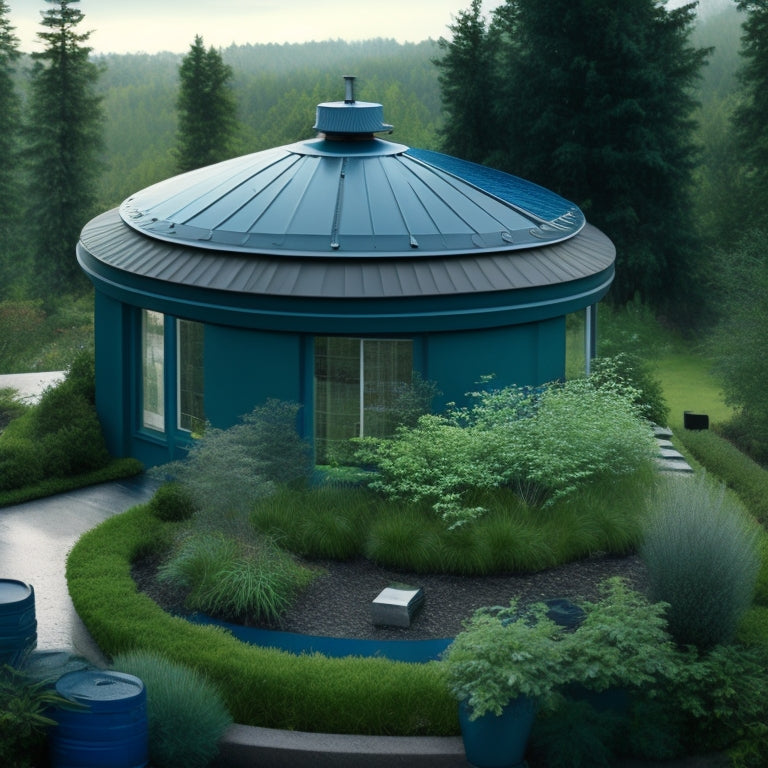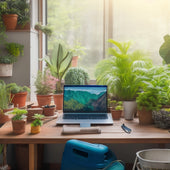
5 Ways to Reduce Stormwater Runoff With Roofs
Share
You can reduce stormwater runoff from your roof by incorporating design elements and materials that absorb or redirect rainfall. Vegetated roofs, for instance, can absorb up to 70% of rainwater, alleviating pressure on urban drainage systems. Selecting the right green roof materials, such as water-retentive growing media and drainage layers, also plays an essential role. Additionally, the roof's angle affects runoff rate, and choosing plants with high water storage capacity helps reduce runoff. A well-designed rooftop drainage system can also decrease stormwater runoff. By exploring these strategies further, you'll discover more ways to make a significant impact.
Key Takeaways
• Vegetated roofs with plants having high water-retention capabilities can absorb up to 70% of rainwater, reducing stormwater runoff.
• Using water-retentive growing media, roof insulation, and drainage layers in green roof materials can minimize stormwater runoff.
• Designing rooftop drainage systems according to roof angle, soil depth, and plant selection can decrease stormwater runoff effectively.
• Selecting plants with high evapotranspiration rates, water storage capacity, and tolerance to flooding can maximize water retention and reduce runoff.
• Regular maintenance of gutter systems, including installing gutter guards, is essential to ensure proper function and reduce stormwater runoff.
Vegetated Roofs Absorb Rainwater
On average, a vegetated roof can absorb up to 70% of the rainwater that falls on it, greatly reducing stormwater runoff. This is a significant benefit, as you'll be contributing to a more sustainable urban environment.
By adopting green infrastructure, you're fundamentally creating a rooftop garden that not only looks beautiful but also plays an important role in stormwater management. The vegetation on your roof will absorb rainwater, reducing the amount of water that flows into storm drains and eventually into nearby waterways. This, in turn, helps to alleviate pressure on urban drainage systems and mitigate the risk of flooding.
As you design your vegetated roof, keep in mind that the type of plants you choose will impact water absorption rates. Opt for plants with high water-retention capabilities to maximize the benefits of your rooftop garden.
Green Roof Materials Matter Most
You'll need to carefully select the materials for your vegetated roof, as they play a noteworthy role in determining its overall performance and water-absorbing capabilities. The right materials can greatly reduce stormwater runoff, while the wrong ones can impede the roof's ability to absorb rainwater.
Here are some key materials to ponder:
-
Water-retentive growing media: This type of media can hold up to 50% of its weight in water, reducing runoff and providing a consistent water supply to plants.
-
Roof insulation: Proper insulation guarantees that the building remains energy-efficient, while also protecting the roof's waterproofing membrane from temperature fluctuations.
-
Drainage layers: These layers prevent water from accumulating on the roof, reducing the risk of waterlogging and plant damage.
- Solar panels: Integrating solar panels into your green roof design can provide a sustainable source of energy, while also mitigating the urban heat island effect.
Roof Angle Affects Runoff Rate
The angle at which your roof is pitched greatly impacts the rate at which stormwater runoff occurs, with steeper roofs generally resulting in faster runoff. This is because water flows more quickly down steeper slopes, leading to increased runoff rates. On the other hand, shallower roof slopes allow water to flow more slowly, reducing runoff rates.
| Roof Slope | Runoff Rate | Stormwater Management Strategies |
|---|---|---|
| Steep (45°-90°) | Fast | Implement stormwater management systems, such as gutters and downspouts, to direct water away from buildings. |
| Medium (15°-45°) | Moderate | Incorporate green roof features, like vegetation and permeable membranes, to slow down runoff. |
| Shallow (0°-15°) | Slow | Opt for permeable pavement and rain gardens to allow water to infiltrate the soil. |
As a homeowner or builder, understanding the relationship between roof slope and runoff rate is essential for implementing effective stormwater management strategies. By selecting the right roof angle and incorporating complementary features, you can greatly reduce stormwater runoff and contribute to a more sustainable environment.
Plant Selection Impacts Retention
Your plant selection plays a critical role in determining the water retention capacity of your green roof, as different species possess varying levels of water-absorbing capabilities. When choosing plants, think about those that thrive in moist conditions and have deep roots to maximize water uptake. This will help reduce stormwater runoff and alleviate pressure on drainage systems.
Here are some key factors to think about when selecting plants for your green roof:
-
Water storage capacity: Choose plants with high water storage capacity to minimize runoff.
-
Soil composition: Select plants that thrive in your roof's specific soil composition for the best growth.
-
Drainage capacity: Think about plants that can tolerate occasional flooding and have adapted to survive in areas with low drainage capacity.
- Evapotranspiration rates: Select plants with high evapotranspiration rates to maximize water loss through plant processes.
Rooftop Drainage System Design
By incorporating a well-designed rooftop drainage system, stormwater runoff can be greatly decreased, and the overall performance of your green roof can be optimized.
You'll want to make sure that your drainage system is tailored to your rooftop garden's specific needs, considering factors like soil depth, plant selection, and rainfall intensity. A well-designed system won't only decrease stormwater runoff but also enhance drainage efficiency, reducing the risk of waterlogging and erosion.
Regular gutter maintenance is essential to guarantee your drainage system functions correctly. Make sure to clean your gutters regularly to prevent debris buildup, which can hinder water flow and lead to overflow.
You can also consider installing a gutter guard or screen to minimize maintenance needs.
Frequently Asked Questions
Can I Install a Green Roof on an Existing Building?
'You'll face retrofitting challenges, requiring structural modifications, when installing a green roof on an existing building; carefully assess the load-bearing capacity and waterproofing to guarantee a successful, liberating transformation that brings new life to the structure.'
How Do I Maintain a Vegetated Roof to Ensure Its Effectiveness?
You'll guarantee your vegetated roof's effectiveness by performing regular roof maintenance, including plant care and drainage maintenance, which will yield numerous benefits, such as improved water retention, reduced erosion, and enhanced biodiversity.
Are There Any Incentives for Implementing Stormwater-Reducing Roofs?
You'll find financial freedom in government incentives, like tax credits and rebates, which offset the cost of stormwater-reducing roofs, providing a triple win: environmental benefits, cost benefits, and a lighter load on your wallet.
Can I Use a Green Roof for Recreational or Habitable Space?
You can design a green roof for recreational or habitable space, leveraging benefits like insulation and biodiversity, but guarantee your design accommodates structural loads, waterproofing, and maintenance access for a functional, thriving space.
How Long Does a Green Roof Typically Last Before Replacement?
You'll find that a green roof's lifespan typically ranges from 20 to 50 years, depending on maintenance, with some lasting up to 60 years. When it's time for roof replacement, expect costs to be around $10 to $20 per square foot.
Related Posts
-

10 Essential Tips for Sizing Block Planters Perfectly
When sizing block planters, you need to take into account multiple factors to get it just right. Measure your cinder ...
-

10 Essential Tips for Sizing Block Planters Perfectly
When sizing block planters, you need to take into account multiple factors to get it just right. Measure your cinder ...
-

10 Essential Tips for Sizing Block Planters Perfectly
When sizing block planters, you need to take into account multiple factors to get it just right. Measure your cinder ...
-

10 Essential Tips for Sizing Block Planters Perfectly
When sizing block planters, you need to take into account multiple factors to get it just right. Measure your cinder ...
-

10 Essential Tips for Sizing Block Planters Perfectly
When sizing block planters, you need to take into account multiple factors to get it just right. Measure your cinder ...
-

10 Essential Tips for Sizing Block Planters Perfectly
When sizing block planters, you need to take into account multiple factors to get it just right. Measure your cinder ...
-

10 Essential Tips for Sizing Block Planters Perfectly
When sizing block planters, you need to take into account multiple factors to get it just right. Measure your cinder ...
-

10 Essential Tips for Sizing Block Planters Perfectly
When sizing block planters, you need to take into account multiple factors to get it just right. Measure your cinder ...
-

10 Essential Tips for Sizing Block Planters Perfectly
When sizing block planters, you need to take into account multiple factors to get it just right. Measure your cinder ...
-

10 Essential Tips for Sizing Block Planters Perfectly
When sizing block planters, you need to take into account multiple factors to get it just right. Measure your cinder ...
-

10 Essential Tips for Sizing Block Planters Perfectly
When sizing block planters, you need to take into account multiple factors to get it just right. Measure your cinder ...
-

10 Essential Tips for Sizing Block Planters Perfectly
When sizing block planters, you need to take into account multiple factors to get it just right. Measure your cinder ...
-

10 Essential Tips for Sizing Block Planters Perfectly
When sizing block planters, you need to take into account multiple factors to get it just right. Measure your cinder ...
-

10 Essential Tips for Sizing Block Planters Perfectly
When sizing block planters, you need to take into account multiple factors to get it just right. Measure your cinder ...
-

10 Essential Tips for Sizing Block Planters Perfectly
When sizing block planters, you need to take into account multiple factors to get it just right. Measure your cinder ...
-

10 Essential Tips for Sizing Block Planters Perfectly
When sizing block planters, you need to take into account multiple factors to get it just right. Measure your cinder ...
-

10 Essential Tips for Sizing Block Planters Perfectly
When sizing block planters, you need to take into account multiple factors to get it just right. Measure your cinder ...
-

10 Essential Tips for Sizing Block Planters Perfectly
When sizing block planters, you need to take into account multiple factors to get it just right. Measure your cinder ...
-

10 Essential Tips for Sizing Block Planters Perfectly
When sizing block planters, you need to take into account multiple factors to get it just right. Measure your cinder ...
-

10 Essential Tips for Sizing Block Planters Perfectly
When sizing block planters, you need to take into account multiple factors to get it just right. Measure your cinder ...
-

10 Essential Tips for Sizing Block Planters Perfectly
When sizing block planters, you need to take into account multiple factors to get it just right. Measure your cinder ...
-

10 Essential Tips for Sizing Block Planters Perfectly
When sizing block planters, you need to take into account multiple factors to get it just right. Measure your cinder ...
-

10 Essential Tips for Sizing Block Planters Perfectly
When sizing block planters, you need to take into account multiple factors to get it just right. Measure your cinder ...
-

10 Essential Tips for Sizing Block Planters Perfectly
When sizing block planters, you need to take into account multiple factors to get it just right. Measure your cinder ...
-

10 Essential Tips for Sizing Block Planters Perfectly
When sizing block planters, you need to take into account multiple factors to get it just right. Measure your cinder ...
-

10 Essential Tips for Sizing Block Planters Perfectly
When sizing block planters, you need to take into account multiple factors to get it just right. Measure your cinder ...
-

10 Essential Tips for Sizing Block Planters Perfectly
When sizing block planters, you need to take into account multiple factors to get it just right. Measure your cinder ...
-

10 Essential Tips for Sizing Block Planters Perfectly
When sizing block planters, you need to take into account multiple factors to get it just right. Measure your cinder ...
-

10 Essential Tips for Sizing Block Planters Perfectly
When sizing block planters, you need to take into account multiple factors to get it just right. Measure your cinder ...
-

10 Essential Tips for Sizing Block Planters Perfectly
When sizing block planters, you need to take into account multiple factors to get it just right. Measure your cinder ...
-

10 Essential Tips for Sizing Block Planters Perfectly
When sizing block planters, you need to take into account multiple factors to get it just right. Measure your cinder ...
-

10 Essential Tips for Sizing Block Planters Perfectly
When sizing block planters, you need to take into account multiple factors to get it just right. Measure your cinder ...
-

10 Essential Tips for Sizing Block Planters Perfectly
When sizing block planters, you need to take into account multiple factors to get it just right. Measure your cinder ...
-

10 Essential Tips for Sizing Block Planters Perfectly
When sizing block planters, you need to take into account multiple factors to get it just right. Measure your cinder ...
-

10 Essential Tips for Sizing Block Planters Perfectly
When sizing block planters, you need to take into account multiple factors to get it just right. Measure your cinder ...
-

10 Essential Tips for Sizing Block Planters Perfectly
When sizing block planters, you need to take into account multiple factors to get it just right. Measure your cinder ...
-

10 Essential Tips for Sizing Block Planters Perfectly
When sizing block planters, you need to take into account multiple factors to get it just right. Measure your cinder ...
-

10 Essential Tips for Sizing Block Planters Perfectly
When sizing block planters, you need to take into account multiple factors to get it just right. Measure your cinder ...
-

10 Natural Ways to Clean Your Planters
You can transform your planters from grimy to gleaming with these 10 natural cleaning solutions. Mix baking soda and ...
-

10 Natural Ways to Clean Your Planters
You can transform your planters from grimy to gleaming with these 10 natural cleaning solutions. Mix baking soda and ...
-

10 Natural Ways to Clean Your Planters
You can transform your planters from grimy to gleaming with these 10 natural cleaning solutions. Mix baking soda and ...
-

10 Natural Ways to Clean Your Planters
You can transform your planters from grimy to gleaming with these 10 natural cleaning solutions. Mix baking soda and ...
-

10 Natural Ways to Clean Your Planters
You can transform your planters from grimy to gleaming with these 10 natural cleaning solutions. Mix baking soda and ...
-

10 Natural Ways to Clean Your Planters
You can transform your planters from grimy to gleaming with these 10 natural cleaning solutions. Mix baking soda and ...
-

10 Natural Ways to Clean Your Planters
You can transform your planters from grimy to gleaming with these 10 natural cleaning solutions. Mix baking soda and ...
-

10 Natural Ways to Clean Your Planters
You can transform your planters from grimy to gleaming with these 10 natural cleaning solutions. Mix baking soda and ...
-

10 Natural Ways to Clean Your Planters
You can transform your planters from grimy to gleaming with these 10 natural cleaning solutions. Mix baking soda and ...
-

10 Natural Ways to Clean Your Planters
You can transform your planters from grimy to gleaming with these 10 natural cleaning solutions. Mix baking soda and ...
-

10 Natural Ways to Clean Your Planters
You can transform your planters from grimy to gleaming with these 10 natural cleaning solutions. Mix baking soda and ...
-

10 Natural Ways to Clean Your Planters
You can transform your planters from grimy to gleaming with these 10 natural cleaning solutions. Mix baking soda and ...
-

10 Natural Ways to Clean Your Planters
You can transform your planters from grimy to gleaming with these 10 natural cleaning solutions. Mix baking soda and ...
-

10 Natural Ways to Clean Your Planters
You can transform your planters from grimy to gleaming with these 10 natural cleaning solutions. Mix baking soda and ...
-

10 Natural Ways to Clean Your Planters
You can transform your planters from grimy to gleaming with these 10 natural cleaning solutions. Mix baking soda and ...
-

10 Natural Ways to Clean Your Planters
You can transform your planters from grimy to gleaming with these 10 natural cleaning solutions. Mix baking soda and ...
-

10 Natural Ways to Clean Your Planters
You can transform your planters from grimy to gleaming with these 10 natural cleaning solutions. Mix baking soda and ...
-

10 Natural Ways to Clean Your Planters
You can transform your planters from grimy to gleaming with these 10 natural cleaning solutions. Mix baking soda and ...
-

10 Natural Ways to Clean Your Planters
You can transform your planters from grimy to gleaming with these 10 natural cleaning solutions. Mix baking soda and ...
-

10 Natural Ways to Clean Your Planters
You can transform your planters from grimy to gleaming with these 10 natural cleaning solutions. Mix baking soda and ...
-

10 Natural Ways to Clean Your Planters
You can transform your planters from grimy to gleaming with these 10 natural cleaning solutions. Mix baking soda and ...
-

10 Natural Ways to Clean Your Planters
You can transform your planters from grimy to gleaming with these 10 natural cleaning solutions. Mix baking soda and ...
-

10 Natural Ways to Clean Your Planters
You can transform your planters from grimy to gleaming with these 10 natural cleaning solutions. Mix baking soda and ...
-

10 Natural Ways to Clean Your Planters
You can transform your planters from grimy to gleaming with these 10 natural cleaning solutions. Mix baking soda and ...
-

10 Natural Ways to Clean Your Planters
You can transform your planters from grimy to gleaming with these 10 natural cleaning solutions. Mix baking soda and ...
-

10 Natural Ways to Clean Your Planters
You can transform your planters from grimy to gleaming with these 10 natural cleaning solutions. Mix baking soda and ...
-

10 Natural Ways to Clean Your Planters
You can transform your planters from grimy to gleaming with these 10 natural cleaning solutions. Mix baking soda and ...
-

10 Natural Ways to Clean Your Planters
You can transform your planters from grimy to gleaming with these 10 natural cleaning solutions. Mix baking soda and ...
-

10 Natural Ways to Clean Your Planters
You can transform your planters from grimy to gleaming with these 10 natural cleaning solutions. Mix baking soda and ...
-

10 Natural Ways to Clean Your Planters
You can transform your planters from grimy to gleaming with these 10 natural cleaning solutions. Mix baking soda and ...
-

10 Natural Ways to Clean Your Planters
You can transform your planters from grimy to gleaming with these 10 natural cleaning solutions. Mix baking soda and ...
-

10 Natural Ways to Clean Your Planters
You can transform your planters from grimy to gleaming with these 10 natural cleaning solutions. Mix baking soda and ...
-

10 Natural Ways to Clean Your Planters
You can transform your planters from grimy to gleaming with these 10 natural cleaning solutions. Mix baking soda and ...
-

10 Natural Ways to Clean Your Planters
You can transform your planters from grimy to gleaming with these 10 natural cleaning solutions. Mix baking soda and ...
-

10 Natural Ways to Clean Your Planters
You can transform your planters from grimy to gleaming with these 10 natural cleaning solutions. Mix baking soda and ...
-

Must-Have Tools for Building Block Planters Online
When building block planters online, you'll need essential tools to guarantee a sturdy and visually appealing structu...
-

Must-Have Tools for Building Block Planters Online
When building block planters online, you'll need essential tools to guarantee a sturdy and visually appealing structu...
-

Must-Have Tools for Building Block Planters Online
When building block planters online, you'll need essential tools to guarantee a sturdy and visually appealing structu...
-

Must-Have Tools for Building Block Planters Online
When building block planters online, you'll need essential tools to guarantee a sturdy and visually appealing structu...
-

Must-Have Tools for Building Block Planters Online
When building block planters online, you'll need essential tools to guarantee a sturdy and visually appealing structu...
-

Must-Have Tools for Building Block Planters Online
When building block planters online, you'll need essential tools to guarantee a sturdy and visually appealing structu...
-

Must-Have Tools for Building Block Planters Online
When building block planters online, you'll need essential tools to guarantee a sturdy and visually appealing structu...
-

Must-Have Tools for Building Block Planters Online
When building block planters online, you'll need essential tools to guarantee a sturdy and visually appealing structu...
-

Must-Have Tools for Building Block Planters Online
When building block planters online, you'll need essential tools to guarantee a sturdy and visually appealing structu...
-

Must-Have Tools for Building Block Planters Online
When building block planters online, you'll need essential tools to guarantee a sturdy and visually appealing structu...
-

Must-Have Tools for Building Block Planters Online
When building block planters online, you'll need essential tools to guarantee a sturdy and visually appealing structu...
-

Must-Have Tools for Building Block Planters Online
When building block planters online, you'll need essential tools to guarantee a sturdy and visually appealing structu...
-

Must-Have Tools for Building Block Planters Online
When building block planters online, you'll need essential tools to guarantee a sturdy and visually appealing structu...
-

Must-Have Tools for Building Block Planters Online
When building block planters online, you'll need essential tools to guarantee a sturdy and visually appealing structu...
-

Must-Have Tools for Building Block Planters Online
When building block planters online, you'll need essential tools to guarantee a sturdy and visually appealing structu...
-

Must-Have Tools for Building Block Planters Online
When building block planters online, you'll need essential tools to guarantee a sturdy and visually appealing structu...
-

Must-Have Tools for Building Block Planters Online
When building block planters online, you'll need essential tools to guarantee a sturdy and visually appealing structu...
-

Must-Have Tools for Building Block Planters Online
When building block planters online, you'll need essential tools to guarantee a sturdy and visually appealing structu...
-

Must-Have Tools for Building Block Planters Online
When building block planters online, you'll need essential tools to guarantee a sturdy and visually appealing structu...
-

Must-Have Tools for Building Block Planters Online
When building block planters online, you'll need essential tools to guarantee a sturdy and visually appealing structu...
-

Must-Have Tools for Building Block Planters Online
When building block planters online, you'll need essential tools to guarantee a sturdy and visually appealing structu...
-

Must-Have Tools for Building Block Planters Online
When building block planters online, you'll need essential tools to guarantee a sturdy and visually appealing structu...
-

Must-Have Tools for Building Block Planters Online
When building block planters online, you'll need essential tools to guarantee a sturdy and visually appealing structu...


